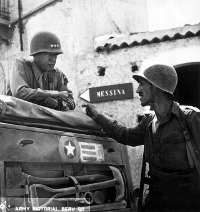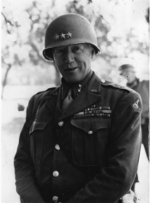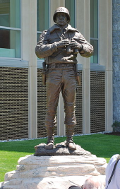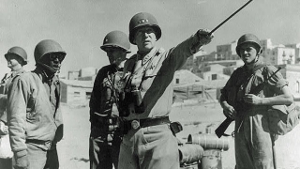General George Patton
Part 2: Rise to Prominence
The U.S. Army called on Patton again in World War II. He was promoted to brigadier general and also earned a pilot's license. He commanded the 1st and 2nd Armored Divisions of the army, training in the California desert after the Japanese attack on Pearl Harbor and then landing with his troops in Morocco, poised for an assault on the Axis-held Mediterranean. He was the commander in America's first major victory against Germany, in March 1943 at the Battle of El Guettar, in Tunisia. 
He was at the head of the 7th Army's invasion of Sicily (engaging with a not-so-friendly competition with British General Bernard Montgomery) and then the 3rd Army's occupation of German-occupied France and then Germany itself, driving back the German advance that began in the Battle of the Bulge. In these actions, he demonstrated yet again his ability to inspire his troops to go farther and faster and more effectively than other people thought possible. In 1945, Patton and the 3rd Army captured 10,000 square miles of German territory in 10 days. Patton, as America's most celebrated commander, had thought to lead the Allied invasion of France. Instead, he was a decoy. As part of Operation Fortitude, American and British intelligence officials spread a story about a large invasion of the First United States Army Group being led by Patton that would land at Calais, the French location that was closest to the United Kingdom. The story was so good and the details so vivid that German officials did believe that Patton would be leading the main invasion, so much so that the initial response to the D-Day landings at Normandy was muted because the Germans thought that it was the diversion. Patton returned to America after the surrender of Germany. He gave a few speeches, including to a crowd of 100,000 in Los Angeles. He requested a posting to the Pacific, to try to finish the war there, but was denied. Instead, he was sent back to Europe, to be the military governor of Bavaria. A car crash in December 1945 claimed Patton's life. He sustained serious injuries in the crash, on December 9, and died 12 days later. He was buried in Luxembourg City, at his request next to some of the men who served under him in the 3rd Army. He had been working on a memoir, War as I Knew It. It was published in 1947. 
Patton gained a reputation as a controversial figure. He was relentless in his pursuit of opportunities for the glories of war. He drove the men under his command hard and expected great things from them; they usually delivered. Outspoken and impatient, he had a temper that got the better of him at times. After his daring invasion of Sicily succeeded in wresting that island away from the Axis occupation, he slapped two soldiers who were suffering from shell shock and accused them of being cowards. The response from General Dwight D. Eisenhower was harsh, and Patton issued a public apology. He was removed form his post in Germany after he made veiled threats against the Soviet Union and seemed to denigrate efforts to remove the remaining elements of Nazi influence from Germany's government. 
He also had a reputation as a great motivator, giving inspiring speeches to his troops and encouraging them to the incredible things of which he asked them. One of the most famous things he said was in a speech to the 3rd Army. To paraphrase, "No one ever won a war by dying for his country. He won it by making the enemy die for his country." He was known for his audacious battle plans and his ability to use his infantry and tanks to cover large swathes of ground, not only in battle but also between battles. He was known for the Colt .45 revolver and the .357 Magnum he always had with him. He was generally regarded by the Axis Powers as the most feared commander the Allies could feature in the theater of war. First page > A Military Life > Page 1, 2 |
|
Social Studies for Kids
copyright 2002–2025
David White



 He made lieutenant colonel in 1934 and received orders to report to Hawaii. In 1937, he wrote a paper in which he predicted a surprise Japanese attack on Hawaii. Also in that year, he was kicked by a horse and nearly died after complications from the injury.
He made lieutenant colonel in 1934 and received orders to report to Hawaii. In 1937, he wrote a paper in which he predicted a surprise Japanese attack on Hawaii. Also in that year, he was kicked by a horse and nearly died after complications from the injury.
